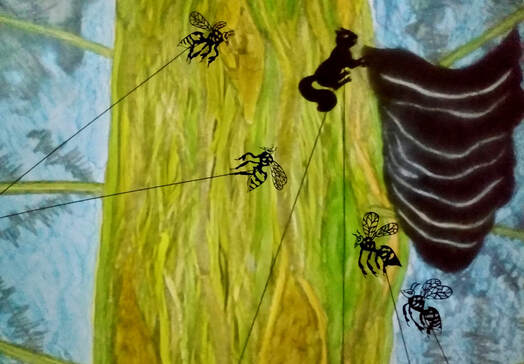 J.S. Bach's manuscript for Der Geist hilft J.S. Bach's manuscript for Der Geist hilft Der Geist hilft unser Schwachheit auf is the only motet for which we have not only the autograph but also almost all of the performance parts, and we know (almost) exactly when it was performed and why. Der Geist hilft was written for the funeral of Johann Heinrich Ernesti who was the rector (or headmaster) of the Thomasschule where Bach was the choirmaster. Ernesti was also the professor of poetry at Leipzig University, and in the early 18th century that primarily meant studying ancient Roman poets. He gained fame for his writings about Cicero (ironically not a poet.) Ernesti did write poetry himself, but primarily in the form of Curriculum Vitaes for his students, apparently a strange but common practice at the time. A couple years after his death CVs would be required to be written in prose form as Leipzig University had had enough of this overly witty poetic frippery. As rector of Thomasschule Ernesti was a bit negligent, which might be why Bach liked him. We know that Ernesti died on October 16, 1729, but there’s a little bit more confusion as to when his funeral was held. It was somewhere between October 20 and October 24, and while his death was by no means unexpected it did happen suddenly, leaving Bach between 4 and 8 days to compose Der Geist hilft. At least the text was already chosen for him as Ernesti had specified he wanted the text for his funeral service to come from Romans 8:26-27. Here’s the full text of the motet in German and English:
 Komm, heiliger Geist Komm, heiliger Geist The words for the chorale come from the third verse of Martin Luther’s hymn, Komm, heiliger Geist, Herre Gott (the melody of this chorale is quite old, possibly related to a piece by Marchetto di Padua from the early 14th century.) The textual choice of this chorale was likely Bach's alone. He also used this chorale in his cantatas: Wer mich liebet, der wird mein Wort halten, BWV 59; and Er rufet seinen Schafen mit Namen, BWV 175. There is some speculation that while the chorale was definitely performed at the funeral, it may not have been intended as part of the motet since orchestral parts are not written for it, only choral parts. It’s possible that the chorale was sung a cappella at the graveside rather than at the end of the motet, but then again it’s also possible that the instrumental parts have been lost. Because Bach had such a short time to compose this motet it’s thought that he likely pilfered bits and pieces from pre-existing works. I mean, Bach was a genius who was also great at recycling his own work, so this isn’t wholly remarkable, but I can’t help but marvel as a singer how the chorus learned this piece that quickly! I think though that this partially explains why Bach used instrumentation in this motet, the only one for which instruments are explicitly called for (strings double choir one and reeds double choir two, and there is of course the requisite continuo part.) There are other reasons for using instruments too, mainly that this was a special solemn occasion that called for some extra musical oomph. It is also likely that Bach’s Thomasschule choir was joined by choral forces from Leipzig University since the funeral was held at the university church, the Paulinerkirche. The use of at least some instrumentation in motets may also have been German tradition, usually it was just organ or continuo, but since this is the only motet of Bach’s that has instrumental parts written out we don’t really know what kind of instrumentation, if any, was used for the others.  Johann Heinrich Ernesti March 12, 1652 - October 16, 1729 Johann Heinrich Ernesti March 12, 1652 - October 16, 1729 The conjecture around Bach’s reuse of pieces in the composition of Der Geist hilft is really interesting. There is a separate six bar composition on the back of the motet manuscript without words, which seems “cantata like” and has led musicologist Alfred Dürr to think it may have come from a lost cantata. It’s also possible that Der Geist hilft is a reworking of a cantata that Bach was already in the middle of composing (or even rehearsing), but when Ernesti died the focus switched. This would mean that the cantata used as a model for this motet never actually existed in a finished form. There’s also the thought that the opening section with the sopranos in each choir trading off motifs comes from a lost duet, but that is also pure conjecture. Bach was also clearly working with the text from memory because he forgot the word “selbst” and had to add it in later, which messed up his musical lines a little bit. You can read much more about all this here, but it’s really long, so search for “Dürr” to find the more salient bits. As I like to say, the first performance of a piece is usually not the best performance, so I imagine that this funeral performance was probably pretty rough. I’d also like to give a shout out to Anna Magdalena and Carl Philip Emmanuel Bach for all their hard work copying the parts, you guys rock! Personally, this is one of my favorite motets. It’s just so jazzy, syncopated, and fun to sing! I guess that’s another argument in favor of Bach parodying himself here because the music really does feel too joyful for a funeral motet. As far as the puppets are concerned Der Geist hilft represents the “path of wood.” You can read more about the overall concept behind the puppet show here. To recap briefly, I designed the puppet show so that each motet represents one path toward enlightenment (or unity with God, Source, All That Is, what have you.) Each path is based off an element, but I’m borrowing elements from various world traditions, so here we have wood as an element. The piece starts off with four squirrels playing in the grass at the base of a giant Douglas-fir tree. They begin climbing together, giving up and going back one by one until there is only one squirrel left. This lone squirrel braves all sorts of obstacles on his ascent including a raccoon, two crows, bugs, an owl, an eagle, and even a swarm of wasps. At one point he fights a couple of songbirds for a cage of suet that some crazy climber hung way up high in the tree. As the chorale begins the squirrel is up so high the clouds pass him, but he carries on, eventually reaching the top as it disappears into the light. I thought this a fitting metaphor for God helping our weakness. Squirrels aren’t the strongest beasts, but they do have their talents. As long as we are each aware of our own strengths, and believe in ourselves, maybe God will help us succeed on the path most suited to our abilities. The set for this motet, a moving scroll (or “crankie”) is definitely the star of the show at almost 25 feet long! That’s long, but shorter than the one I made for Komm, Jesu, komm. I made it to imitate climbing a tree, so I used math to figure out a very gradual forced perspective. The tree goes from filling the screen to collapsing into a single point over the course of 18 scenes, and I took great liberty with the colors and textures of the wood. My dad saw it and thought it gave off a lava lamp kind of effect. Some of the colors are most unwood-like, but it was definitely fun to paint! Why a Douglas-fir? I have a special relationship to these trees, and I visit them in parks whenever I can. I remember lying beneath one in Salmon Bay Park weeping and burning with fever after a breakup only to return to that tree years later to find it weeping too. I once wrote a poem that included a fir tree “clinging with sap and scent” only to find one the next day in Schmitz Preserve Park sparkling in the way I had envisioned. For me Douglas-firs are spiritual protectors and grief eaters. I'll leave you with the poem I’m referring to. It’s at least somewhat related to the concept of God, or spirit, helping our weakness.
You can catch the show, a collaboration between Paper Puppet Opera and Seattle Bach Choir, on Sunday, March 12, 2023 at 7:30 PM at Our Redeemer's Lutheran Church in the Ballard neighborhood of Seattle. Entrance is by donation only, so come early, and bring opera glasses. Oh, and March 12 also happens to be Johann Heinrich Ernesti's birthday!
0 Comments
Leave a Reply. |
AuthorHi, Juliana Brandon here. This is where I let you peek behind the scenes here at Paper Puppet Opera. See works in progress, rehearsal snippets, and learn more about the history behind each production. Archives
March 2023
Categories |





 RSS Feed
RSS Feed